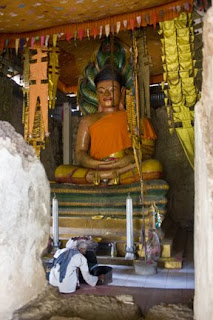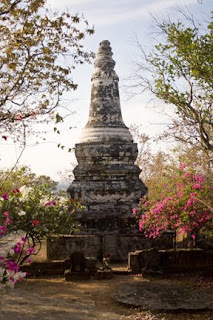
 The hot and sticky summers in April, May and June bring the season of the best fruits of the tropics. This naturally includes durian, which of course you must eat with mangosteens (arguably one of the better things about Asia) or else your body temperature rises too much. But then again, this is when mangoes are falling off the trees on the roads and there’s just too much for consumption including exports. So I guess I can handle that waft of durian odor once in a while….
The hot and sticky summers in April, May and June bring the season of the best fruits of the tropics. This naturally includes durian, which of course you must eat with mangosteens (arguably one of the better things about Asia) or else your body temperature rises too much. But then again, this is when mangoes are falling off the trees on the roads and there’s just too much for consumption including exports. So I guess I can handle that waft of durian odor once in a while….
Dyed chicks in Jakarta
 Can you believe this?? I think my shock was a little disabling. We rounded the corner on a tuk tuk and came upon this scene only enough to capture a single shot before the traffic converged to block the view and we were whisked off. Inside the cage on the different levels are chicks dipped in various colored dye. I mean, as a child in Manila I think I found this sort of atrocity cute since I myself was party to the doom of several baby animals I made my mom purchase for me at the market. I guess it is a luxury to have this mentality of animal harassment (cruelty?)…
Can you believe this?? I think my shock was a little disabling. We rounded the corner on a tuk tuk and came upon this scene only enough to capture a single shot before the traffic converged to block the view and we were whisked off. Inside the cage on the different levels are chicks dipped in various colored dye. I mean, as a child in Manila I think I found this sort of atrocity cute since I myself was party to the doom of several baby animals I made my mom purchase for me at the market. I guess it is a luxury to have this mentality of animal harassment (cruelty?)…
Day Trip from Phnom Penh to Phnom Oudong
This trip was a 50minute motorbike ride to the outskirts of Phnom Penh on a very hot Sunday. This is a typical panoramic view of Cambodia in the North-South region Siem Reap – Sihanoukville: flat as a pancake dry and dotted with palm and coconut trees, etc. Elevations are revered spots and wats (pagodas) are usually constructed on top of them.


 These images of Buddha in various interpretations are not for idolising, such as Christians worship the images of the God. These images aim to inspire the appropriate mode of behaviour towards the personal achievement of enlightenment. It is an admired philosophy, especially during these modern fast-paced times, but its lack of appreciation for personal gains contributes to the detriment of Asian society (values?) in an age of materialism and the pursuit of wealth.
These images of Buddha in various interpretations are not for idolising, such as Christians worship the images of the God. These images aim to inspire the appropriate mode of behaviour towards the personal achievement of enlightenment. It is an admired philosophy, especially during these modern fast-paced times, but its lack of appreciation for personal gains contributes to the detriment of Asian society (values?) in an age of materialism and the pursuit of wealth.
 I have no idea what kind of turtles these are, but a lot of them are classified ‘threatened’ in Cambodia. We were taken once to a restaurant in Kampot Province, where the walls were lined with WWF and conservancy posters. Obviously it’s illegal to hunt those animals on the posters, but enforcement capacity is low. They were the menu offerings, but only hush hush. If officials came through the door the establishment is upholding the law.
I have no idea what kind of turtles these are, but a lot of them are classified ‘threatened’ in Cambodia. We were taken once to a restaurant in Kampot Province, where the walls were lined with WWF and conservancy posters. Obviously it’s illegal to hunt those animals on the posters, but enforcement capacity is low. They were the menu offerings, but only hush hush. If officials came through the door the establishment is upholding the law. No shortage of cutesy shots in the third world. Sadly this is exploited and children are sometimes harmed in order to garner more sympathy and thus more money from foreigners.
No shortage of cutesy shots in the third world. Sadly this is exploited and children are sometimes harmed in order to garner more sympathy and thus more money from foreigners.
 At wats around the country there are soothsayers who will read palms, feet, sticks, and tea leaves. Philosophies about fate and destiny are major factors why the region has not lived to its full capacity in the past several centuries compared to the West.
At wats around the country there are soothsayers who will read palms, feet, sticks, and tea leaves. Philosophies about fate and destiny are major factors why the region has not lived to its full capacity in the past several centuries compared to the West. This woman makes 3 baskets in one day. Then sells each basket for 1000 Riel (25 cents) for a small one, or 3000 Riel (75 cents) for a big one the size of a cantaloupe. I can never look at the handicrafts in a Pier1 store ever again, since coming out to Asia.
This woman makes 3 baskets in one day. Then sells each basket for 1000 Riel (25 cents) for a small one, or 3000 Riel (75 cents) for a big one the size of a cantaloupe. I can never look at the handicrafts in a Pier1 store ever again, since coming out to Asia. The prize part of a crab is the fat inside the shell. Here they are sold by a vendor at the market. These are river crabs, small enough to fit nicely in a child’s hand. The shell / fat is sold for 600 Riel (~24 cents) and the whole crab for 1000 Riel (25 cents).
The prize part of a crab is the fat inside the shell. Here they are sold by a vendor at the market. These are river crabs, small enough to fit nicely in a child’s hand. The shell / fat is sold for 600 Riel (~24 cents) and the whole crab for 1000 Riel (25 cents).

 There were probably five mosques on the way to Oudong from Phnom Penh, which surprised us. Muslims make up 10% of Cambodia’s population, the largest group after Buddhists, but they’re largely concentrated in Kampot and Kampong Cham (Cham is the Khmer word for Muslim). Saudi Arabia finances the building of mosques here. Their presence has been slowly increasing, since the finding of oil off Cambodia’s coasts.
There were probably five mosques on the way to Oudong from Phnom Penh, which surprised us. Muslims make up 10% of Cambodia’s population, the largest group after Buddhists, but they’re largely concentrated in Kampot and Kampong Cham (Cham is the Khmer word for Muslim). Saudi Arabia finances the building of mosques here. Their presence has been slowly increasing, since the finding of oil off Cambodia’s coasts.
All photos from Keith A Kelly‘s photostream.
Market scene at Phnom Oudong
 Notice the eggs to this seller’s right? These are newly hatched Khmer delicacies (post-Khmer Rouge) sold only on the streets by a man pushing a barbecue cart, blasting a recording: “Eggs, they’re good for you and yummy too”. A small hole is cut into the shell and the egg is sucked out, mixed with lots of spices, stuffed back in, skewered and barbecued. I’ve seen it done, it actually works. I don’t personally like the taste of these things, though I am a big fan of eggs.
Notice the eggs to this seller’s right? These are newly hatched Khmer delicacies (post-Khmer Rouge) sold only on the streets by a man pushing a barbecue cart, blasting a recording: “Eggs, they’re good for you and yummy too”. A small hole is cut into the shell and the egg is sucked out, mixed with lots of spices, stuffed back in, skewered and barbecued. I’ve seen it done, it actually works. I don’t personally like the taste of these things, though I am a big fan of eggs. This couple has a barbecue stand, along with all the other barbecue stands selling all manner of meat. She is wrapping up my lunch purchase (chicken) in a lotus leaf. The ones roasting nearest is a stuffed frog– ground pork or beef mixed with onions and serious spices.
This couple has a barbecue stand, along with all the other barbecue stands selling all manner of meat. She is wrapping up my lunch purchase (chicken) in a lotus leaf. The ones roasting nearest is a stuffed frog– ground pork or beef mixed with onions and serious spices. This family sells palm fruit at the market at Phnom Oudong. They’re the transluscent square or oval shaped pieces of fruit in the glass fruit cocktail jars at Asian markets in the US. Filipinos love these in their fruit salads. I’ll get a close-up next time.
This family sells palm fruit at the market at Phnom Oudong. They’re the transluscent square or oval shaped pieces of fruit in the glass fruit cocktail jars at Asian markets in the US. Filipinos love these in their fruit salads. I’ll get a close-up next time.
More photos in a later post (I will steal my husband’s pro shots and post them here hehehe). I’m getting sleepy.
.
Engrish Signs
Scene in Phnom Penh
 My view from the treadmill at the gym. Running east towards the Mekong River (which is at the top of this photo) is Sihanouk Blvd. Independence Monument, commemorating the war dead and independence from colonial rule (France) in 1953, is at the intersection with Norodom Blvd. The parks on either side of the monument are hubs of activity.
My view from the treadmill at the gym. Running east towards the Mekong River (which is at the top of this photo) is Sihanouk Blvd. Independence Monument, commemorating the war dead and independence from colonial rule (France) in 1953, is at the intersection with Norodom Blvd. The parks on either side of the monument are hubs of activity.
The street grid under French rule composed of wide main boulevards lined with trees. Fortunately the not-so-often wise leadership decided that this is an asset. The municipality has recently begun a spate of beautification projects around the city, making medians more inviting and family-friendly like this one. It’s part of a wider effort at attracting tourism, as most visit the country for just three days– all three of which is spent in Siem Reap’s Angkor Wat archeological zone.
